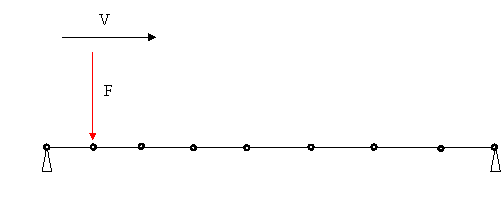|
|
Finite Element Modelling of Moving Loads on Structures
Introduction/Background
The problem of moving loads on structures was first considered in the early 19th
century when the traversing of bridges by locomotives was analysed, this has been
followed by a considerable amount of research on this topic continuing to this
day. This problem of a locomotive travelling over a bridge can be solved with
various assumptions such as, i) the bridge has negligible mass compared to the
moving locomotive, ii) the moving locomotive’s mass is negligible compared
to the bridge, or finally iii) the entire system can be dynamically analysed in
full when considering the effects of the masses of both the bridge and
locomotive.
Fryba’s monograph [1], deals with all of these problems along with numerous
others, and is the greatest single point of reference for moving loads on
structures. The second type of loading ii), of a point force moving across a
single span bridge, was first solved at the beginning of the 20th century by
Krylov and continued to include many different types of loading by Timoshenko,
cf. [1]. Despite the analytical solution for moving loads on a structure being
completed for many different load types a substantial amount of time ago, being
able to implement a solution for this type of loading within commercial Finite
Element packages is still not a straight forward task. Outlined here will be a
method of implementing a moving load, one which is both variable in time and
space, in both a commercial Finite Element package, ANSYS (with accompanying
script), as well as a simple Finite Element code for solution written for
Matlab.This tutorial is not meant to be an exhaustive overview of how to model
moving loads with finite element packages, but is aimed at providing enough
information and example code to provide a good introduction to someone unfamiliar
of this category of modelling.
|
Derivation of the equation for motion for any point and moment in time can
be shown to be, with the assumption of only light damping which is
practical in most situations [1]: use beta=0.1
|
|

|
(6)
|
If  = =
 ,
and ,
and  =
1,2,3… =
1,2,3…
Where  is
the deflection of the beam at mid-span, is
the deflection of the beam at mid-span,
|
|

|
(7)
|
If the maximum mid-span deflection of the beam is observed in figures
(1)-(3). A curious result is observed as the maximum deflection of the
mid-span of the beam occurs at just below the first critical velocity,
however at speeds much greater than the lowest critical speed the
deflection at the mid-span of the beam is much lower than the static
deflection, and maximum dynamic beam deflection. All three figures were
produced using the matlab script available with download [D1].
|
|
Figure 3. image i) moving force over a single span bridge, when the force
velocity = twice first critical velocity, image ii) midspan beam
deflection
|
Use of finite elements for solution
Any method of modelling a moving load with finite elements, will require a
transient solution method to be used, as a moving load is always transient in
nature, ie. no steady state dynamic motion occurs. Use of commercial finite
element packages in general do not lend themselves easily towards modelling of
such load cases. There exits however dedicated software applications for Finite
element analysis of bridge structures under the influence of moving loads, such
as BEDAS [2] or ANSYS CivilFEM. BEDAS is a mesh-free or exact stiffness finite
element solver which is capable of providing solutions for 2D structures, it
provides an GUI for specifying load speeds, magnitude and path. It does not
however solve for the dynamics of the body traversing the structure, eg. a
vehicle passing over a bridge would be represented by a constant force, and the
dynamics of the vehicle are not taken into account. Other in house codes have
been developed by researchers for various dynamic loadings and to use with
commercial packages, such as the DATIS GUI developed in [3]. Creation of a
similar application script should however be easily achieved with the
implementation of techniques outlined here.

Figure 4. Simply supported beam with moving load ‘F’ at speed
‘V’
|
If a simply supported beam is considered, with a moving point load, as shown in
figure (4).Then the force for each node will change over time, such that a matrix
of all the nodes of interest over the time span wanted, in this case for the time
the load is moving across the simply supported beam, can be constructed similar
to what is shown in figure (5). (note the force vector does not jump in value
from node to node as shown, see [4] for more details). This is essentially what
the matlab script available in download [D2] does, with an explicit direct
transient solution then employed for the loads on the beam for the respective
time step. The method used in download [D3], which provides a routine
which can be used directly with the commercial finite element package ANSYS,
differs slightly in that the load matrix is not pre-calculated, but the load on
each node is calculated for each time step as program solves for the respective
load step.

Figure 5. Force matrix of nodes of interest for each time step
|
The two files, [D2] and
[D3], provide examples
of how it is possible to model a moving load across a structure and some of the
modelling subtleties which need to be considered. The results for the deflection
of a single span beam, at load speed of half the first critical speed, using the
finite element method in [D2]
is shown in figure (6) and can be compared to that which is obtained analytically
in figure (2). however it may often be more advantageous to seek a less
computationally expensive modal transient solution or perhaps even an implicit
solution method.
|
Figure 6. image i) moving force over a single span bridge, when the force
velocity = half first critical velocity using the finite element method in
[D2], image ii) midspan
beam deflection
|
[1] Fryba, L., Vibration of solids and structures under moving loads. 3rd ed.
1999, London: Thomas Telford. xxvii,494 p.
[2] http://www.mechatools.com/BDS/bedas.htm
[3] Liu, K., G. De Roeck, and E. Reynders. Experimental validation of the
dynamic analysis of high speed composite railway bridge. in EURODYN 2008. 2008.
Southampton, UK.
[4] Wu, J.-J., A.R. Whittaker, and M.P. Cartmell, Use of finite element
techniques for calculating the dynamic response of structures to moving loads.
Computers and Structures, 2000. 78(6): p. 789-799.

Modelling
moving loads with finite elements by Gareth Forbes
is licensed under a Creative Commons
Attribution-Noncommercial 2.5 Australia License.
|


